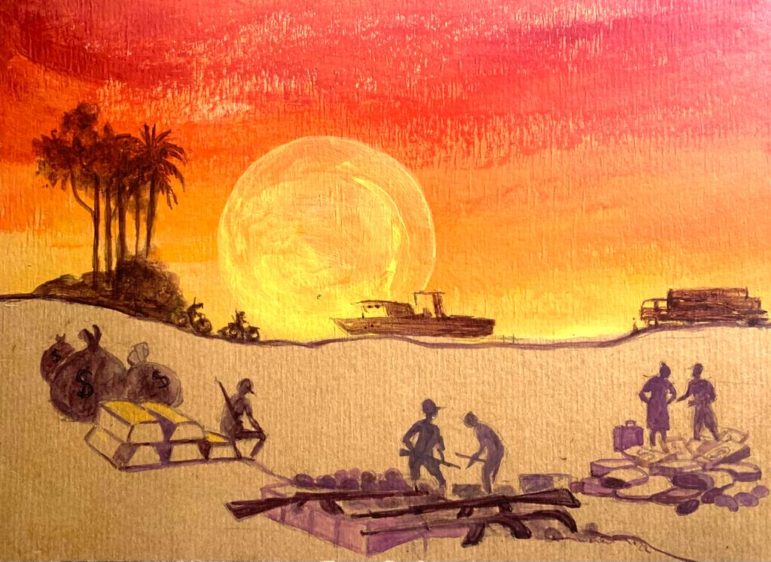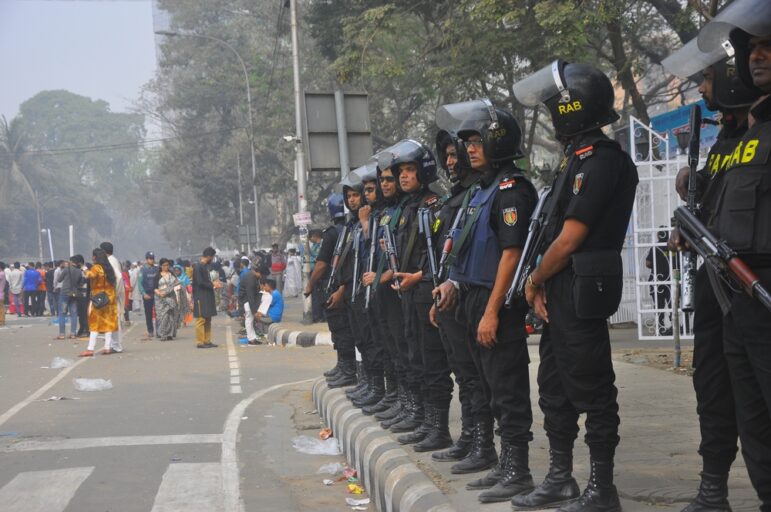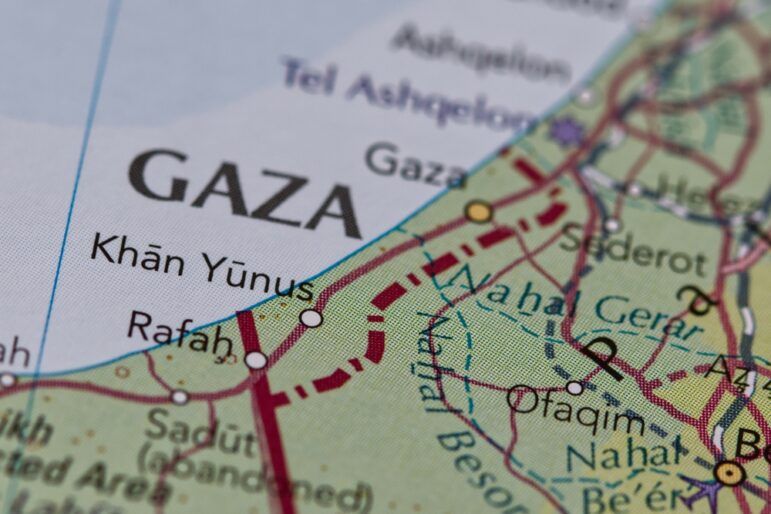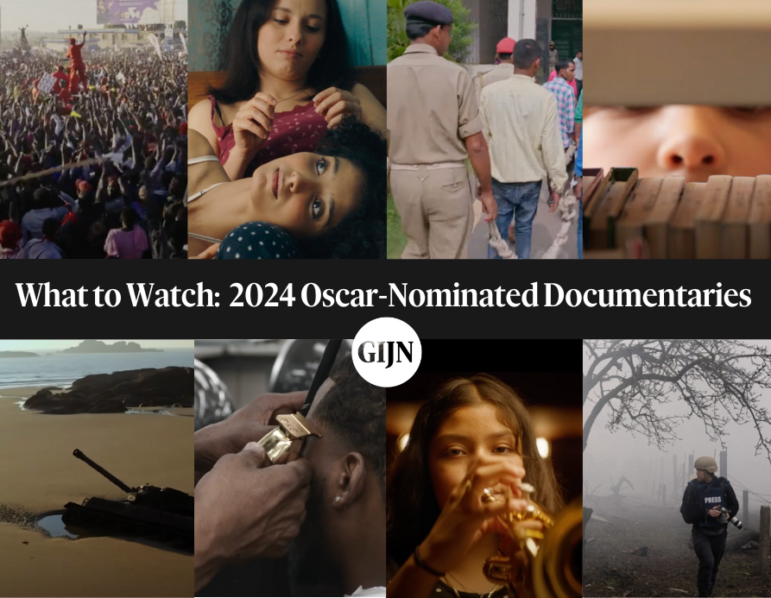

Illustration: Marcelle Louw for GIJN
Reporter Katie McQue’s Tips for Covering Migrant Workers in Arab Gulf States
Read this article in
One of the world’s toughest places to practice investigative journalism is the Arab Gulf region, a string of six states bordering the Persian Gulf that includes Bahrain, Kuwait, Oman, Qatar, Saudi Arabia and the United Arab Emirates (UAE).
Saudi Arabia is one of the worst countries in the world for jailing journalists. An absolute monarchy, the country tied with Russia last year for eighth place in the Committee to Protect Journalists’ annual report documenting attacks on the press. Bahrain came in at 14th on that same list, jailing six.
There is also mounting concern about surveillance tactics being used by governments in the region. Saudi Arabia and the UAE are among those who have acquired Pegasus spyware, which has been used to surveil scores of journalists around the world.
More than 23 million migrant workers live in these six countries, where abuse of the workers is widespread. GIJN’s guide to reporting on Migration in the Gulf, which was updated last year, highlighted how media outlets “both local and international, have generally struggled to closely cover human trafficking and forced labor in the region… because of the restrictions on press freedom, security concerns, and threats of detention or deportation.”
But despite these difficulties, a few intrepid local and foreign journalists have been able to report on previously untouchable topics.
One of them is Katie McQue, a British freelance journalist who spent five years reporting from Dubai covering human rights and migration alongside her “business” beats of energy, healthcare, and finance. She received a fellowship from GIJN in 2017 designed to help journalists in the Gulf cover human trafficking and forced labor.
Majdolin Hasan, GIJN’s Arabic editor, talked with McQue about her work and the best practices reporters can adopt when covering forced labor and human trafficking in the region.
GIJN: Can you tell us what your investigations are about, and what they have revealed about human trafficking in the Middle East?
KM: My investigations are about human rights issues encountered by migrant workers in the United Arab Emirates and the rest of the Gulf. They have included reproductive rights of female migrant workers, exposés of cross-border human trafficking networks, mass exploitation of migrant seafarers in Iran (where many were forced to work on vessels involved in dangerous smuggling activities), the treatment of detained African migrants in Saudi Arabia, the abandonment of laborers by their employers, and unexplained disappearances of domestic workers.
GIJN: How did you manage to find the trafficking victims and other people featured in your stories, and how did you gain their trust?
KM: Just like any other beat, it’s essential to build a network of sources and speak to them as often as possible. My source network is mainly migrant workers impacted by the issues I’m investigating. I’ll meet them in person, whenever possible, or we have calls or WhatsApp conversations. Plus, I’m constantly reaching out to new people.
To gain trust, the main issue is representing yourself and your capacity as a journalist accurately. Reporters are not activists or human rights campaigners, and this needs to be made clear to the interviewee. It’s never, ever acceptable to raise an interviewee’s hopes that by talking to you their problems can be solved. I always take time to explain what my work as a reporter is about, and why I’d like to speak to them.
It’s important to remember that the interviewee is likely a survivor of trauma. Let them go at their own pace and never pressure them into telling you things they’re very uncomfortable discussing. Sometimes I’ll interview migrant workers in several shorter conversations, over a period of several days or weeks, whenever they are free and willing to talk.
GIJN: After reaching out to these people and discovering signs of significant exploitation against them, how did you plan your investigation and move forward?
KM: I look to speak to as many migrant workers as I can who are impacted by the issue I’m investigating, to build up a super clear picture of the situation. For instance, for a piece I wrote for The Washington Post about a human trafficking network sending Filipino females to Syria to work as maids, I spoke to 17 women and girls that had been trafficked. For a more recent Post investigation on seafarer exploitation, I interviewed 26 workers that had been tricked into working in Iran for little or no pay. The more interviews, the better. I always ask my interviewees for additional pieces of documentary evidence they may have that verifies their account. This can be photos or videos of their accommodation, videos of abuse they’ve suffered, travel documents or receipts for illicit recruitment fees they have paid, business cards, and Facebook profiles of their traffickers, voicemails, etc.
GIJN: Do you have any interview techniques that help you when probing into sensitive and intimate details about how these people were treated by their employers and work agencies?
KM: Recognize the huge power imbalance at play between the reporter and interviewee, who is likely in a very vulnerable position, and try to alleviate it in certain ways. I always start by letting the interviewee lead the conversation, so they are more comfortable. There are usually one or two things they really want to get off their chest, so we discuss those first and branch out from there.
I make sure the interviewee knows they can stop talking at any time, and I don’t pressure them into telling me anything that may re-traumatize them. I ask quite a few questions about their lives back home, their hopes for the future, and things that help me get a sense of who they are.
For me, it’s important to get a lot of details about different incidents they tell me — this also helps me write ‘scenes’ in my features. If I start asking them a lot of really detailed questions about small, incremental things, I usually tell them why I’m asking these questions — like, “I’m trying to get a sense of this” or “understand that.” Just so they understand why I’m asking what I’m asking, and don’t feel like they’re being interrogated.
I also ask a lot about how they felt, reacted, or what they were thinking, during each of the incidents we talk about occurred.
GIJN: What are your best tips on investigating cross-border human trafficking?
KM: Source protection is obviously key. If somebody who has been trafficked is speaking to you while they are still in captivity, don’t include their full name or anything that could identify them in your reporting as you could be putting their safety at risk.
GIJN: Have you faced any backlash for your reporting in the countries where you have been investigating the issue?
KM: I lived in the UAE for five years, up until the end of last year, and I didn’t face any backlash from the authorities. The UAE doesn’t have a free press, but I wasn’t subjected to the same pressures as local media because I was getting my stories published by international newspapers.
I had some self-imposed rules I followed, which I think helped. During my time there, I never wrote comment pieces and I refrained from Tweeting too much about local politics and human rights issues, to maintain my objectivity. I was an accredited journalist in the UAE with my own work visa, as I also held a staff job reporting about energy, so I couldn’t be accused of working there without permission, which carries a huge penalty.
Before publication of each story, I gave governments ample time — at least three days — to respond to any allegations raised in my piece. And I would only pitch my stories to large international publications. One of my reasons for this is I feel like there is less likely to be backlash from the government than if I was publishing stories with smaller or independent websites.
GIJN: You started reporting on human trafficking and forced labor issues in the Gulf and worldwide after taking a fellowship with GIJN in this subject; how did the program help you to dig deeper into this topic?
KM: I’d reported on human trafficking and forced labor issues before the fellowship, but the GIJN workshop in Amman, Jordan, was helpful in my preparations to start reporting on these subjects in the Gulf. We learned about structuring investigations and digital security, which were invaluable. The mentors also helped me focus my angle for what I wanted to work on and gave me a lot of useful feedback. Before the fellowship, international journalists in the Gulf had told me it’s impossible to write about human rights while living there, and self-censorship among journalists and editors in the UAE is a huge problem. The fellowship made me realize I absolutely can.
This story is the first in a series looking at investigative journalism in the Middle East and North Africa region.
Additional Resources
Reporting on Migration in the Gulf: A GIJN Guide
Reporter’s Guide to Investigating Organized Crime: Human Trafficking, by Martha Mendoza
How They Did It: Investigating the Trafficking of Girls from Nepal to the Gulf
 Majdolin Hasan, GIJN’s Arabic editor, is an award-winning journalist who has worked with Global Integrity, 100Reporters, and Arab Reporters for Investigative Journalism. She was the director of an investigative journalism unit in Jordan and was the first Jordanian to file a case against the Jordanian government for denying her right to public information.
Majdolin Hasan, GIJN’s Arabic editor, is an award-winning journalist who has worked with Global Integrity, 100Reporters, and Arab Reporters for Investigative Journalism. She was the director of an investigative journalism unit in Jordan and was the first Jordanian to file a case against the Jordanian government for denying her right to public information.











